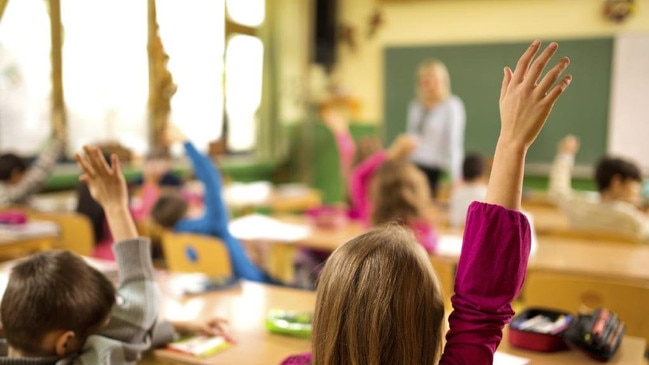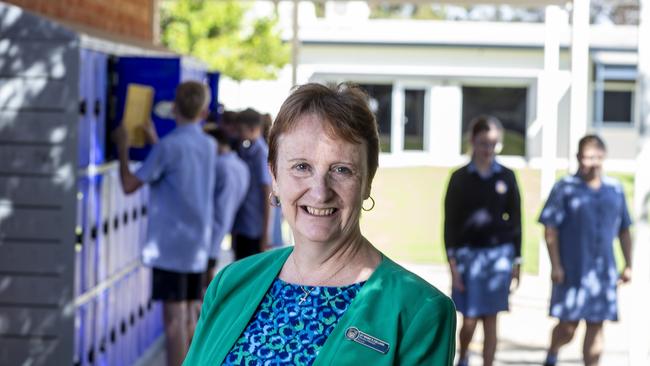New classroom behaviour model to be rolled out in schools
SA students will be explicitly taught how say please and thank you, be quiet when entering a classroom and how to line up. Do you agree with the new old-school behaviour model?
SA News
Don't miss out on the headlines from SA News. Followed categories will be added to My News.
Australian students will be taught old-school discipline – including how to line up, keep quiet and be still – in a bid to rid classrooms of the behaviour crisis that sees teachers routinely abused, attacked and children disrupted.
The new model of school discipline will be rolled out nationally this year, after a Senate inquiry heard horror tales of students hurling furniture at teachers, keying their cars, punching them, stealing wallets – all while disrupting their peers from learning.
It can be revealed Australian students will be explicitly taught how to enter the classroom quietly, how to sit, how to listen properly and how to ask questions, with strategies varying from school to school.
Schools are also moving back to traditional classroom arrangements with desks lined up in rows facing the teacher.
Experts say children no longer come to school knowing how to behave and must be explicitly taught not to call out, talk among themselves and run around the classroom.
But the strategy will likely receive backlash from some teachers who feel unsupported to deal with out-of-control school violence.
The new model is based on a behaviour curriculum in the UK which incorporates strategies including a red and yellow card system of warnings for disruptive children and “super walking,” which means adults leading lines of children single-file around the school.
Schools are also requiring students to pack up, stand behind their chairs and wait to be dismissed table by table at the end of classes.
It will be up to individual teachers in Australia which discipline elements they teach. The UK model has mandatory and legally enforceable guidelines.
It comes as the OECD recently found Australian classrooms have a disciplinary climate that is among the “least favourable” in the world, ranked 33 out of 37 countries.
Just seven per cent of students said they felt safe in the classroom due to violent outbursts from other students and a lack of respect for teachers, which sees them hit, punched, kicked and threatened.
One quarter of students said the environment in their school was not conducive to learning and one third do not listen to what teachers say.
The Australian Education Research Organisation (AERO) is distributing evidence-based teaching material to education departments around the country outlining practical steps to teach children how to behave. Teachers in NSW and Tasmania were first to receive the guidance with Victoria, Queensland, Western Australia and South Australia to follow this year with an expectation schools distribute the material to all teachers.

AERO chief executive Jenny Donovan said the key was to “treat behaviour like a curriculum and ensure it is explicitly taught”.
“We can’t assume students understand the expectations,” she said. “It’s really resonating with teachers and it’s what students say they want. They want a sense of safety in the classroom, so they can learn without distraction.”
But some researchers warn using a curriculum model to teach kids how to behave is “taking us backwards”.
Melissa Close from Queensland University of Technology said the model ignored the fact that all students were different.
“Instead of using fear and consequences as motivators, we should focus on fostering connections, empathy, and relationships to guide behaviour,” she said.
Erin Leif from Monash University said while evidence showed the behaviour curriculum was applied with some success overseas, the long- term impact was less clear.
“Are they going to look back and think about being at a school where there were clear boundaries and expectations or are they going to say they were treated like a soldier?” she said.
The notion of a behaviour curriculum was a key finding from the Senate Inquiry in Disruption in Schools chaired by Western Australian Liberal Senator Matt O’Sullivan.
He said the approach was about “establishing key habits of behaviour” adapted for each school environment.
“No child is born knowing how to behave and if you can learn it then you can teach it. It needs to be taught explicitly with clear expectations rather than a list of prohibited behaviour,” he said.
A number of Australian schools have already adopted a behaviour curriculum including Marsden Road Primary School in NSW and Challis Community School and Dawson Park Primary School in WA.
The panel also wants an annual survey of behaviour in schools, school learning climate and frequency and impact of disruptive behaviour.

St Mark’s College in Port Pirie is among schools to take up a program, introduced by Catholic Education SA, that teaches correct behaviour and records student misdemeanours.
The Positive Behavioural Interventions and Support (PBIS) program advises teachers to explicitly teach students expected behaviour in schools using positive reinforcement.
It has been nine months since St Mark’s implemented the program and school leadership has already seen “the calmest start to the year”, principal Sandra Hewson said.
“It’s (PBIS) all couched in very positive language, ‘we will do this’, ‘we will be respectful in class’, ‘we will come prepared to class’,” Ms Hewson said.
“It’s built on positive relationships, we don’t want staff to feel they’re arguing and damaging relationships.”
Teachers will note each time behaviour expectations are not met using a “learning behaviour management system” such as refusal to wear a hat outside and students speaking when a teacher is talking.
This data then informs leadership at the Reception to Year 12 school which behaviour needs to be targeted with a new strategic approach.
“Most of it is about teachers reminding students of the procedure we have … and then we’ve seen a drop off in those behaviours,” Ms Hewson said.
When students would not wear a hat outside, Ms Hewson said it “went from being an issue to not being an issue at all” following an assembly and some practice.
The PBIS also includes a three tiered system of behaviour management.
Tier one behaviour is expected without explicit teaching, tier two is undesirable behaviour which may be repeated by students and tier three includes “more extreme” issues such as violent conduct.
Since implementing the system, St Mark’s has had no incidents resulting in suspension so far this year, Ms Hewson said.
“Most schools would have suspension as a tool … it doesn’t work,” she said.
“The behaviours of the students involved weren’t necessarily changing.”
And parents are on board with the new approach.
“This year, we’re seeing parents appreciate a very rational educational approach,” Ms Hewson said.
St Mark’s expects the program to take up to three years to be fully implemented.
More Coverage
Originally published as New classroom behaviour model to be rolled out in schools




